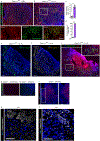Caspase-7 activates ASM to repair gasdermin and perforin pores
- PMID: 35705808
- PMCID: PMC9247046
- DOI: 10.1038/s41586-022-04825-8
Caspase-7 activates ASM to repair gasdermin and perforin pores
Abstract
Among the caspases that cause regulated cell death, a unique function for caspase-7 has remained elusive. Caspase-3 performs apoptosis, whereas caspase-7 is typically considered an inefficient back-up. Caspase-1 activates gasdermin D pores to lyse the cell; however, caspase-1 also activates caspase-7 for unknown reasons1. Caspases can also trigger cell-type-specific death responses; for example, caspase-1 causes the extrusion of intestinal epithelial cell (IECs) in response to infection with Salmonella enterica subsp. enterica serovar Typhimurium (S. Typhimurium)2,3. Here we show in both organoids and mice that caspase-7-deficient IECs do not complete extrusion. Mechanistically, caspase-7 counteracts gasdermin D pores and preserves cell integrity by cleaving and activating acid sphingomyelinase (ASM), which thereby generates copious amounts of ceramide to enable enhanced membrane repair. This provides time to complete the process of IEC extrusion. In parallel, we also show that caspase-7 and ASM cleavage are required to clear Chromobacterium violaceum and Listeria monocytogenes after perforin-pore-mediated attack by natural killer cells or cytotoxic T lymphocytes, which normally causes apoptosis in infected hepatocytes. Therefore, caspase-7 is not a conventional executioner but instead is a death facilitator that delays pore-driven lysis so that more-specialized processes, such as extrusion or apoptosis, can be completed before cell death. Cells must put their affairs in order before they die.
© 2022. The Author(s), under exclusive licence to Springer Nature Limited.
Conflict of interest statement
Declaration of Interests
The authors declare no competing interests.
Figures






















Comment in
-
Hold your horses! Reining in your fastest pores with caspase-7.Immunity. 2022 Aug 9;55(8):1340-1342. doi: 10.1016/j.immuni.2022.07.013. Immunity. 2022. PMID: 35947978
-
Caspase-7 and acid sphingomyelinase: partner repairmans of gasdermin and perforin pores.Signal Transduct Target Ther. 2022 Aug 22;7(1):293. doi: 10.1038/s41392-022-01144-2. Signal Transduct Target Ther. 2022. PMID: 35995788 Free PMC article. No abstract available.
References
METHODS REFERENCES
-
- Kuida K et al. Altered cytokine export and apoptosis in mice deficient in interleukin-1 beta converting enzyme. Science 267, 2000–2003 (1995). - PubMed
MeSH terms
Substances
Supplementary concepts
Grants and funding
- R01 AI119073/AI/NIAID NIH HHS/United States
- R01 AI133236/AI/NIAID NIH HHS/United States
- R01 AI074862/AI/NIAID NIH HHS/United States
- P30 CA016086/CA/NCI NIH HHS/United States
- R56 AI110682/AI/NIAID NIH HHS/United States
- R01 AI050072/AI/NIAID NIH HHS/United States
- R01 AI138337/AI/NIAID NIH HHS/United States
- R01 AI097518/AI/NIAID NIH HHS/United States
- R01 AI143894/AI/NIAID NIH HHS/United States
- R01 AI139304/AI/NIAID NIH HHS/United States
- R56 AI133236/AI/NIAID NIH HHS/United States
- R01 AI136920/AI/NIAID NIH HHS/United States
LinkOut - more resources
Full Text Sources
Molecular Biology Databases
Research Materials

